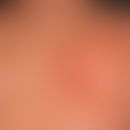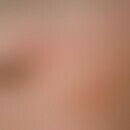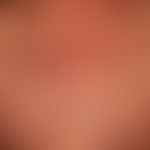Synonym(s)
DefinitionThis section has been translated automatically.
Poikiloderma (poikilos = mottled, marbled) refers to clinically morphologically defined, etiologically different, congenital or acquired, variegated clinical pictures with circumscribed or diffuse atrophy, small-spotted to reticular hyper- and depigmentation, telangiectasia and erythema. Poikiloderma can occur in genetic, inflammatory and neoplastic diseases.
Poikiloderma is typical in cases of chronic UV exposure of the skin or as X-ray late forlgen (radioderm).
The term "poikiloderma" is also used to describe clinical pictures that can be classified as pre-ageing syndromes.
ClassificationThis section has been translated automatically.
A distinction is made according to origin or association with syndromes:
Congenital (primary) poikiloderma (classification in the narrower sense, poikiloderma as a dermatological-clinical signature is indicative of an underlying polyorganic syndrome).
- Rothmund-Thomson syndrome (mutation in the RECQL4 gene) (formerly differentiated as Thomson syndrome and Rothmund syndrome / mutation in the RECQL4 gene)
- Baller-Gerold syndrome (mutation in the RECQL4 gene - see also Rapadilino syndrome)
- Dyskeratosis congenita (Zinsser)
- Poikiloderma, congenital with warty hyperkeratosis (Dowling)
- Kindler syndrome (poikiloderma, congenital with blistering; Marghescu-Braun-Falco syndrome; Brain syndrome)
- Dysplasia, congenital ectodermal with cataract.
Poikiloderma in the context of other congenital syndromes:
- Progeria adultorum (Werner syndrome)
- Hartnup syndrome (metabolic disorder)
- Goltz-Gorlin syndrome (dysplasia syndrome)
- Bloom syndrome (mutation in the BLM gene)
- Amyloidosis, familial poikilodermatic
- Incontinentia pigmenti, Bloch-Sulzberger type
- Clericuzio-type poikiloderma with neutropenia (mutation in C16orf57)
Symptomatic (secondary) poikiloderma (in the context of chronic skin damage, chronic inflammatory or neoplastic underlying diseases):
- Dermatomyositis
- Systemic scleroderma
- Systemic lupus erythematosus
- Parakeratosis variegata
- Mycosis fungoides
- Lichen planus
- Acrodermatitis chronica atrophicans
- Urticaria pigmentosa
- Riehl melanosis
- Poikiloderma, actinic
- X-ray late effects (radioderm)
- Poikiloderma, thermal.
- Facies ethylica
- Chronic graft-versus-host reaction
HistologyThis section has been translated automatically.
Due to the various causes, the histology of poikiloderma can be very variable. Common to all forms is an atrophic epidermis with striated rectal ridges, mild hyperkeratosis, pigment incontinence with melanophages in the papillary body and telangiectasia. Occasionally, vacuolization of the junctional zone with lymphocytes and dyskeratosis is detectable.
LiteratureThis section has been translated automatically.
- Vogl A et al (2005) Skin and alcohol. J Dtsch Dermatol Ges 3: 788-790
Incoming links (25)
Amyloidosis cutaneous special forms; Baller-Gerold syndrome; Berlin syndrome; Dyskeratosis congenita; Dysplasia, congenital ectodermal with cataract; Familial cancer syndrome; Hartnup syndrome; Interface dermatitis; Lower leg pigmentation, hereditary atrophy associated with atrophy; Poikiloderma, acquired; ... Show allOutgoing links (29)
Acrodermatitis chronica atrophicans; Baller-Gerold syndrome; BLM Gene; Bloom syndrome; Dermatomyositis (overview); Dyskeratosis congenita; Dysplasia, congenital ectodermal with cataract; Erythema; Goltz syndrome; Graft-versus-host disease chronic; ... Show allDisclaimer
Please ask your physician for a reliable diagnosis. This website is only meant as a reference.








